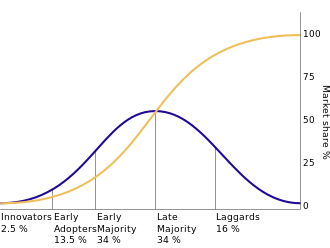
The death of Vilfredo Federico Damaso Pareto in August 1923 didn’t have much impact on the people of Cuero, a small town in Texas, USA.
They were busy getting ready for their annual “Turkeyfest“, a parade in which more than 30,000 people come to see 20,000 turkeys march together down the Main Street of their town, dancing and enjoying with big band music.
Another reason for not grieving over the death of Paretto was that they didn’t really know the guy who died more than 5,000 miles away in Switzerland.
What they also didn’t know was that a few blocks away from the Turkey parade route that was covered with feathers and crumbs of corn, and 3 years later, Frank Bass would be born.
Frank Bass grew up in Cuero, and after graduation he had to decide if he wants to be a cowboy or a professor. The decision was hard. “Cowboys dominate on the honesty dimension, but they are, perhaps, slightly more intelligent than professors. Alas, however, professors make a lot more money than cowboys” He said.
Luckily to the marketing profession he chose to be a professor.
Today he is known as the creator of the Bass diffusion model, which was first introduced in 1963.
Bass diffusion model is one of the solid bases and explanations of the short head theory.

The origins of the Bass diffusion model

In 1962, Professor Everett M. Rogers gave a lecture at Purdue University, where Professor Bass was teaching at that time.
It was a few months after Rogers, who was a professor of rural sociology, published his book “Diffusion of innovations“.
“Diffusion of innovations” tried to explain how innovations (new ideas, objects etc.) are being spread through the communication channels over time and among the members of a social system.
The “spreading” is done by word of mouth and the reason why it is so important is that “new” things are perceived as risky and uncertain. People try to lower the risk by seeking out others like themselves who have already adopted the innovation.
Therefore the diffusion process starts with the innovators, then the early adaptors, who adopt innovation and then spread the word further until the innovation gets to a critical mass.

The book was one of the first attempts to understand how we adopt innovation, a subject that engaged Frank Bass as well.
After Professor Roger gave his speech at Purdue University, one of Frank’s students came to him and asked if there was a way to express the idea of imitators and innovators that Rogers talked about, mathematically.
Frank took a pen and started scratching an answer, a mathematical model that would describe the “Diffusion of innovations” – it didn’t take him long to come up with one.
It did, however, take him another 5 years to write a complete paper that provided empirical support for his model.
Two years later, in 1969, this paper was published as the Bass diffusion model.
Until today the Bass diffusion model is one of the most widely cited and tested models in marketing science.
It also explains why the short head is so huge and getting bigger and bigger!

